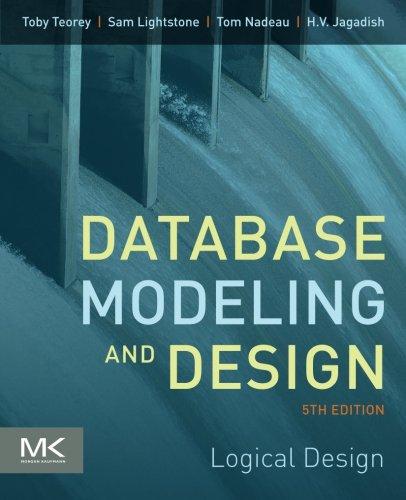Question
Explain how M:N relationship between two entities, say A and B, is transformed into two 1:M relationships. (1 point) Complete exercise 2.2. Do all parts.
Explain how M:N relationship between two entities, say A and B, is transformed into two 1:M relationships. (1 point)
Complete exercise 2.2. Do all parts. You should keep updating the ERD for each additional requirement listed in the exercise. Use ERD Plus for all ERDs. (25 points)
Do exercise 2.4. Use ERD Plus for all ERDs. (5 points)
E2.2 Create the ER diagrams for a scenario based on these requirements:
A health care organization keeps track of its doctors and outpatient locations.
For each doctor it keeps track of the DoctorID (unique), DoctorName, and DoctorYearOfMDGraduation (year of graduating from medical school).
For each outpatient location it keeps track of the OLID (unique) and OLName, and the following additional requirement:
E2.2a Additional requirement
Each doctor works at exactly one outpatient location, and each outpatient location can have between none (rehab and minor health issues only) and many doctors working at it.
E2.2b Additional requirement
Each doctor works at either one outpatient location or at none (strictly working in the
main hospital), and each outpatient location must have at least one but can have many
doctors working at it.
E2.2c Additional requirement
Each doctor works at exactly one outpatient location, and each outpatient location must
have at least one but can have many doctors working at it.
E2.2d Additional requirement
Each doctor works at either one outpatient location or at none (strictly working in the
main hospital), and each outpatient location can have between none (rehab and minor health issues only) and many doctors working at it.
E2.2e Additional requirement
Each doctor works at between none (strictly working in the main hospital), and many
outpatient locations, and each outpatient location must have at least one but can have many doctors working at it.
E2.2f Additional requirement
Each doctor works at between one and many outpatient locations, and each outpatient location must have one but can have many doctors working at it.
E2.2g Additional requirement
Each doctor works at between none (strictly working in the main hospital) and many
outpatient locations, and each outpatient location can have between none (rehab and minor health issues only) and many doctors working at it.
E2.2h Additional requirement
Each doctor works at either one outpatient location or at none (strictly working in the main hospital), and each outpatient location has exactly one doctor working at it.
E2.2i Additional requirement
Each doctor works at exactly one outpatient location, and each outpatient location has exactly one doctor working at it.
E2.2j Additional requirement
Each doctor works at either one outpatient location or at none (strictly working in the
main hospital), and each outpatient location can have between none (rehab and minor health issues only) and one doctor working at it.
E2.2k Additional requirements
Each doctor works at between one and many outpatient locations, and each outpatient
location must have at least one but can have many doctors working at it.
For each occurrence of a doctor working at an outpatient location, we keep track of the
NoOfHoursPerWeek (number of hours per week that a doctor works at an outpatient
location).
E2.2l Additional requirement
Each doctor works at between two and four outpatient locations, and each outpatient location has between three and ten doctors working at it.
E2.2m Additional requirements
Each doctor works at between one and many outpatient locations, and each outpatient location must have at least one but can have many doctors working at it.
Each doctor manages between zero and one outpatient locations, and each outpatient
location has exactly one doctor managing it.
E2.4 Create the ER diagram based on the following requirements:
A health care organization keeps track of outpatient locations and examination rooms within the outpatient locations.
For each outpatient location it keeps track of the OLID (unique) and OLName.
For each examination rooms it keeps track of the ERoomNumber (unique within its outpatient center, but examination rooms in different outpatient locations can have the same ERoomNumber), and ERoomSize. Each outpatient location must have at least one but can have many examination rooms.
Each examination room is located in one outpatient location.
Step by Step Solution
There are 3 Steps involved in it
Step: 1

Get Instant Access to Expert-Tailored Solutions
See step-by-step solutions with expert insights and AI powered tools for academic success
Step: 2

Step: 3

Ace Your Homework with AI
Get the answers you need in no time with our AI-driven, step-by-step assistance
Get Started


